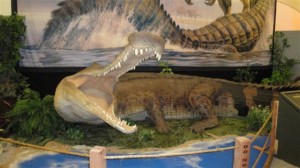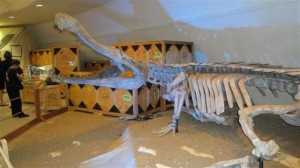The Sternberg Natural History Museum at Fort Hays State University is featuring a new exhibit, The Science of SuperCroc from now until August 5.
The star of the show is the African crocodilian species Sarcosuchus whose remains have been found in the modern Sahara, in the Elrhaz Formation. This Early Cretaceous (~112 million years ago) crocodile had a long, slender snout with a prominent down-turn or hook at the tip. When fully mature it is estimated to have been between 37-40 feet in length, and weighed as much as 17,000 pounds.
The largest living crocodile is the saltwater croc, and the largest confirmed individual was just over 20 feet in length and weighed a mere 2,600 pounds.
Sarcosuchus had its eyes placed high upon its skull suggesting that it spent most of its time submerged in the water. Like so many other things in paleontology, the question of what Sarcosuchus may have eaten is not agreed upon by researchers. Some suggested that the size of Sarcosuchus and its overhanging upper jaw made it able to wrestle large prey items, even massive long-necked sauropod dinosaurs. Others point to the slenderness of the muzzle and it not looking stout enough to withstand the forces that would be required to bring down large prey. There were plenty of lobe-finned fish in Sarcosuchus’s environment. I see a fish-eater in this skull myself.
Also on display with the large croc is Suchomimus, a theropod dinosaur whose remains have been found in the same geological formation as Sarcosuchus. Suchomimus, whose name means crocodile mimic, was a forty-foot long beast which also had a long slender muzzle. Its forelimbs were armed with very long sickle-curved claws. This animal is thought to have eaten fish and probably other sorts of meat, but its skull also does not appear equipped for biting and holding very large struggling prey.
The presence of both of these animals, and many others found with them, show that the Sahara area of today was a lush, swampy habitat in the Early Cretaceous. The effect of climate change and plate movements over millions of years can turn a wet verdant habitat into a harsh, dry desert. My how times change.
Go see SuperCroc at the Sternberg Museum if you have a chance.

